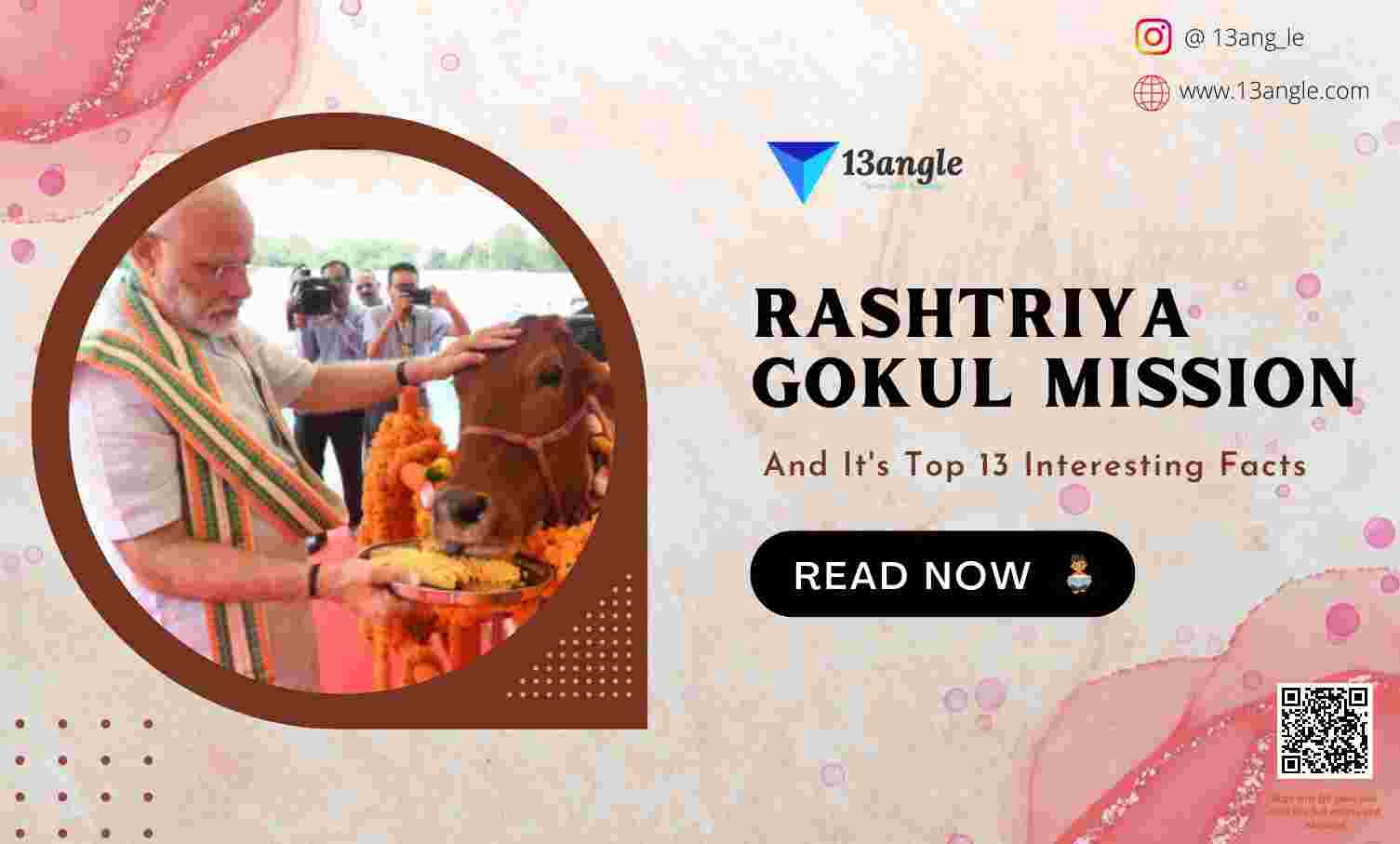- Umang Sagar
- Govt. Initiatives, Recent article
Rashtriya Gokul Mission
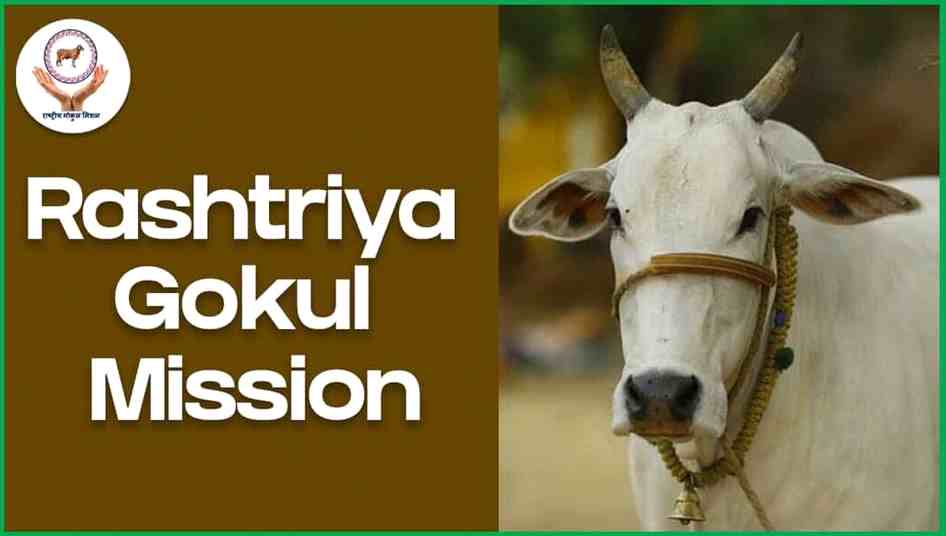
Introduction
The government has launched the Rashtriya Gokul Mission to promote the conservation and development of indigenous breeds of cows in a scientific manner. The Rashtriya Gokul Mission was launched in December 2014 as an initiative to develop and conserve the indigenous bovine breeds for improving the milk production and productivity in a scientific manner which includes superior nutrition and farm management. PM Narendra Modi along with the Ministry of Agriculture & Farmers Welfare announced the implementation of the Rashtriya Gokul Mission. This mission was launched under the National Programme for Bovine Breeding and Dairy Development during the 12th Five Year Plan.
Under Rashtriya Gokul Mission funds have been released for setting up 16 Gokul Grams as Integrated Indigenous Cattle Development Centres with the aim of conserving and developing indigenous bovine breeds in a scientific and holistic manner.
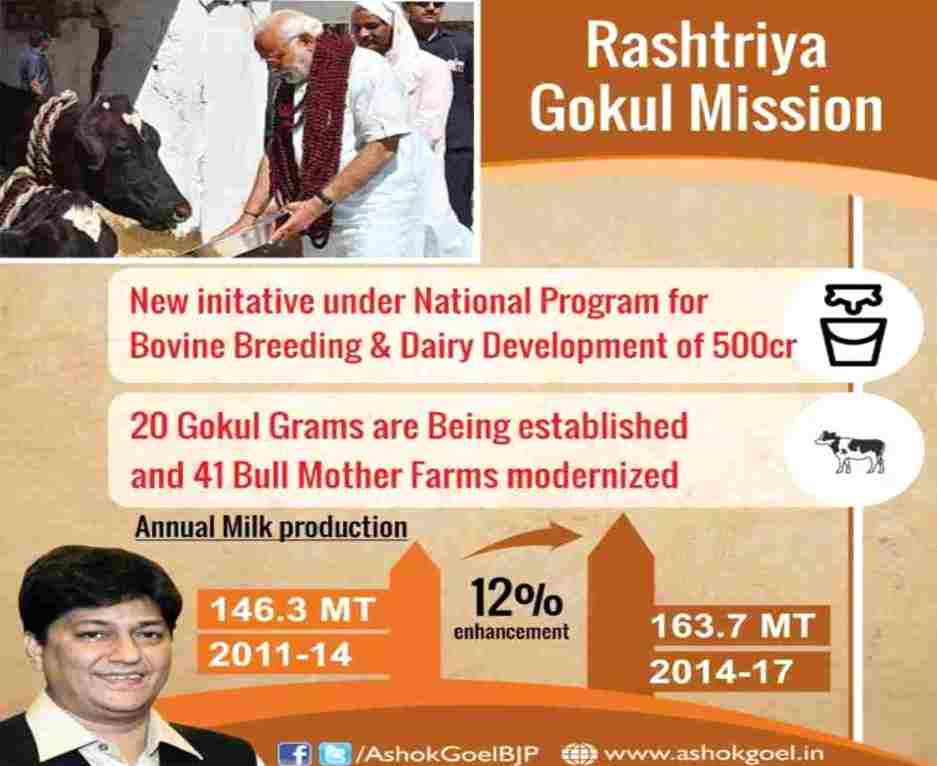
Objectives
To promote indigenous cattle rearing and conservation in a scientific manner.
To enhance the productivity of indigenous breeds and increase economic returns from animal products in a sustainable manner.
To propagate high genetic merit bulls of indigenous breeds.
To encourage appropriate technology for the use of Draught Animal.
To provide balanced nutrition and integrated animal health.
To optimize modern Farm Management practices and promote Common Resource Management.
To promote Green Power and Eco technology.
What Are The Features Of Rashtriya Gokul Mission?
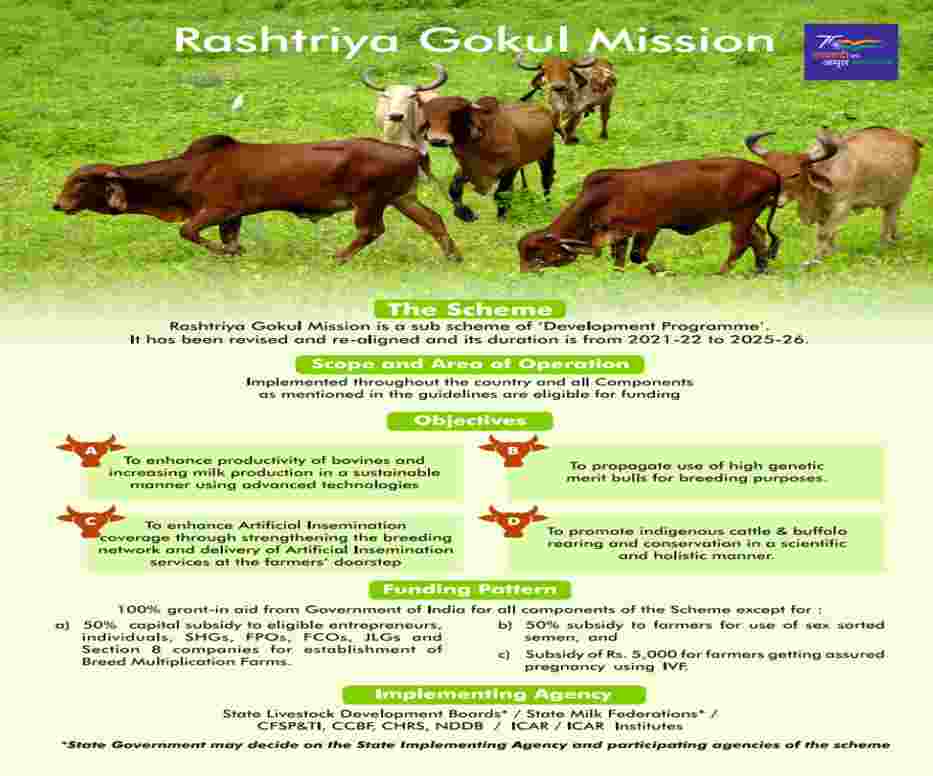
Rashtriya Gokul Mission focuses on establishing integrated cattle development centers or Gokul Grams. These centers will be established in native breeding regions and near metropolitan cities to house the urban cattle.
Under Rashtriya Gokul Mission, the features of these Gokul Grams are as follows –
- They will be independent and will focus on generating economic resources. This will be done through the sale of organic manure, urine distillates, A2 milk and electricity production from biogas.
- These centers will act as local training centers for MAITRIs, farmers, and breeders.
- Gokul Grams will provide farmers in the breeding business with high genetic breeding stock.
- These development centers maintain unproductive and milch animals in the ratio of 40:60. In addition, they can maintain around 1000 animals.
- In Gokul Grams, the house fodder production will provide the nutritional requirements of the animals.
Significant Initiatives Under Rashtriya Gokul Mission
- Awards for encouraging farmers/breeder societies to rear Indigenous breeds of bovines:-
- Gopal Ratna awards: for farmers maintaining the best herd of Indigenous Breed and practicing best management practices.
- Kamdhenu awards: for best managed Indigenous herd by Institutions/Trusts/ NGOs/ Gaushalas or best-managed Breeders’ societies.
Gokul Gram: The Rashtriya Gokul Mission envisages the establishment of integrated cattle development centers, ‘Gokul Grams’ to develop indigenous breeds including up to 40% nondescript breeds (belonging or appearing to belong to no particular class or kind) with objectives to:
- Promote indigenous cattle rearing and conservation in a scientific manner.
- Propagate high genetic merit bulls of indigenous breeds.
- Optimize Modern Farm Management practices and promote Common Resource Management.
- Utilize animal waste in an economical way i.e. Cow Dung, Cow Urine
National Kamdhenu Breeding Centre:- (NKBC) is being established as a Centre of Excellence to develop and conserve Indigenous Breeds in a holistic and scientific manner.
“E-Pashu Haat”- Nakul Prajnan Bazaar:- An e-market portal connecting breeders and farmers, for quality- disease-free bovine germplasm.
Pashu Sanjivni: An animal wellness program encompassing the provision of animal health cards (‘Nakul Swasthya Patra’) along with UID identification and uploading data on the National Database.
Advanced Reproductive Technology: Including Assisted Reproductive Technique- In-vitro Fertilization (IVF)/ Multiple Ovulation Embryo Transfer (MOET) and sex-sorted semen technique to improve the availability of disease-free female bovines.
National Bovine Genomic Center for Indigenous Breeds (NBGC-IB) will be established for selection of breeding bulls of high genetic merit at a young age using highly precise gene-based technology.
Implementing Agency
Rashtriya Gokul Mission will be implemented through the “State Implementing Agency (SIA viz Livestock Development Boards).
State Gauseva Ayogs will be given the mandate to sponsor proposals to the SIAs (LDBs) and monitor the implementation of the sponsored proposal.
All Agencies having a role in indigenous cattle development will be the “Participating Agencies” like ICAR, Universities, Colleges, NGOs, Cooperative Societies, and Gaushalas.
Why Conservation Of Indigenous Breeds Is Required?
Indigenous bovines are robust and resilient and are particularly suited to the climate and environment of their respective breeding tracts and the productivity of indigenous breeds is less likely to be impacted by the adversities of climate change.
The milk of indigenous animals is high in fat and SNF content (The substances in milk other than butterfat and water in the form of casein, lactose, vitamins, and minerals which contribute significantly to the nutritive value of milk).
Facilities
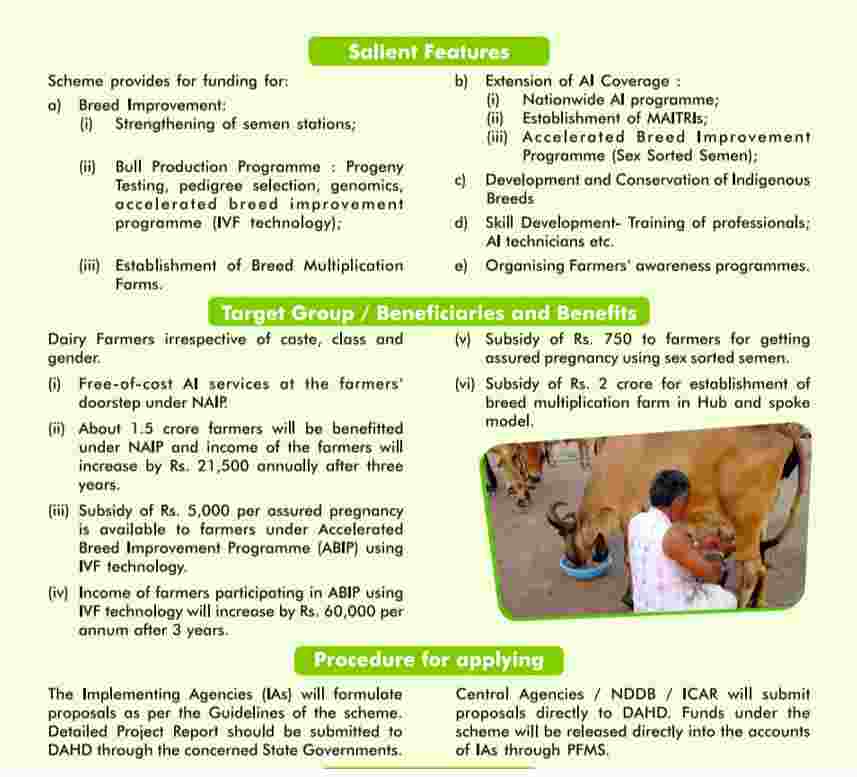
The following facilities have been provided in the Integrated Indigenous Cattle Centres- Gokul Grams:
- cow and calf sheds
- Bio Gas Plant
- Agricultural equipment
- Urine distillation plant
- Compost and Vermicompost pits
- semen and liquid nitrogen and other essential infrastructure.
- The Integrated Indigenous Cattle Centres-Gokul Grams has been made viable and sustainable through the sale of milk, value-added milk products, sale of high genetic merit stock of indigenous breeds produced at Gokul Grams in the form of bulls, heifers, and calves to farmers, breeders, and Institutions, etc.
Components:
- Funds under the scheme are allocated for:
- establishment of IntegratedIndigenous Cattle Centres viz “Gokul Gram”
- strengthening of bull mother farms to conserve high genetic merit Indigenous Breeds
- establishment of Field Performance Recording (FPR) in the breeding tract
- assistance to Institutions/Institutes which are repositories of the best germplasm
- implementation of the Pedigree Selection Programme for the Indigenous Breeds with a large population
- Establishment of Breeder‟s Societies: Gopalan Sangh
- distribution of disease-free high genetic merit bulls for natural service
- the incentive to farmers to maintain elite animals of indigenous breeds
- heifer rearing program; award to Farmers(“Gopal Ratna” ) and Breeders‟ Societies (“Kamadhenu” )
- organization of Milk Yield Competitions for indigenous breeds and
- organization of Training Programme for technical and nontechnical personnel working at the Institute/Institutions engaged in indigenous cattle development.
Top 13 Facts About Rashtriya Gokul Mission
PM Narendra Modi, along with the Ministry of Agriculture & Farmer Welfare, announced the implementation of the Rashtriya Gokul Mission in December 2014.
The State Implementing Agency (SIA) via Livestock Development Boards implements the RGM scheme.
Implemented under the National Programme for Bovine Breeding and Dairy Development (NPBBD), Rashtriya Gokul Mission aims to develop and conserve bovine breeds of India.
It ensures enhanced productivity and production of milk in a scientific manner that includes improved nutrition as well as farm management.
This scheme helps to meet the growing demand for milk in the country. It also makes dairying more lucrative financially to the rural farmers.
The Rashtriya Gokul Mission scheme will continue from 2021 to 2026 under the umbrella scheme Rashtriya Pashudhan Vikas Yojna.
The Rashtriya Gokul Mission Ministry primarily focuses on, Distribution of disease-free bulls with high genetic merit for breeding purposes.
Upgrading of nondescript cattle using elite breeds like Sahiwal, Gir, Rathi, Deoni, Red Sindhi, and Tharparkar.
The scheme also focuses on optimizing modern Farm Management practices and promoting Common Resource Management.
Gokul Grams will provide farmers in the breeding business with high genetic breeding stock. In Gokul Grams, the house fodder production will provide the nutritional requirements of the animals.
The centers will act as local training centers for MAITRIs, farmers, and breeders. These development centers maintain unproductive and milch animals in the ratio of 40:60.
One of the Benefits of the Rashtriya Gokul Mission scheme is to the establishment of dairy infrastructure to improve processing, acquisition, and marketing.
Women will also benefit from this scheme as more than 70% of the livestock work in this country is done by them.



